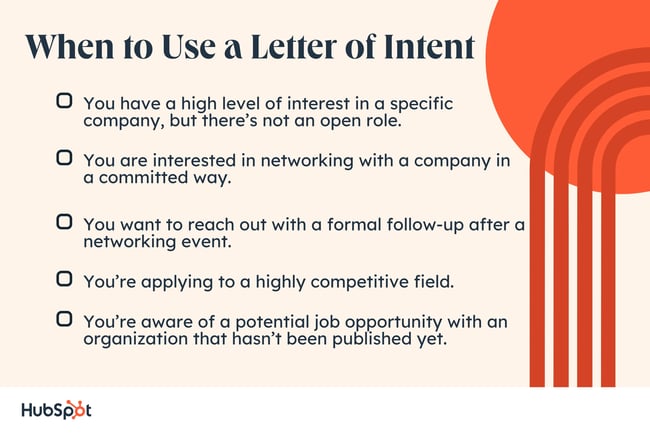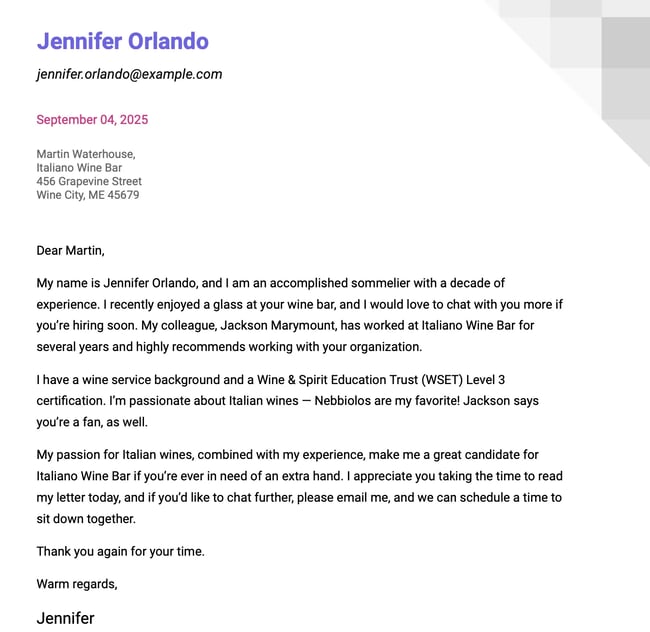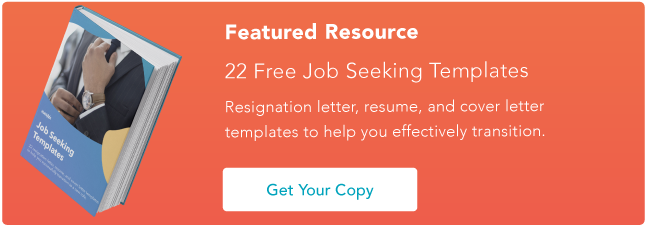Standard job applications have a standard set of practices. You turn in a resume and cover letter, and then, if selected, you move through a few rounds of interviews and get the job.
Standard job applications have a standard set of practices. You turn in a resume and cover letter, and then, if selected, you move through a few rounds of interviews and get the job.
However, not all potential job opportunities start with an application. In fact, many begin with initiative from a job seeker.
Those job seekers will send in a letter of intent rather than a cover letter. In this article, we’ll take a look at what a letter of intent is and highlight some strategies for writing the best LOI you can. We’ve even included a template to help you get started.
Here’s what you’ll find:
What is a letter of intent?
A letter of intent is a less common way of expressing interest in a company. It targets reasons you’re looking for opportunities with a specific organization.
A letter of intent does include elements of a traditional cover letter, such as relevant experience and skills, but it’s used in slightly different contexts. LOIs emphasize alignment between a job seeker and an organization.
.webp?width=650&height=731&name=image1%20(4).webp)
Letter of Intent vs. Cover Letter
There are a few key differences between a cover letter and a letter of intent, including:
-
Context. While a cover letter responds to a specific job listing, a letter of intent targets an organization more generally. It may or may not have a specific job opening at the time that the LOI is sent in.
-
Focus. A cover letter explains why an applicant is a good fit for a specific role. An LOI, on the other hand, addresses an individual’s compatibility with an overall organization or more general role.
-
Initiative. A cover letter is a reactive document responding to a job opening. A letter of intent, however, demonstrates more initiative and provides information before an organization specifically requests it.
Letter of Intent vs. Letter of Interest
Letter of intent and letter of interest are often used interchangeably. While there are a lot of similarities between the two documents, there are also a few key differences:
-
Level of intent. Letters of intent have a high level of intentionality, while letters of interest are more exploratory. A letter of intent proposes action, while letters of interest are for information gathering.
-
Commitment level. A letter of intent is a high-commitment way of expressing interest in a company, while a letter of interest is a lower commitment. An individual is more likely to send out multiple letters of interest.
-
Action orientation. A letter of intent always ends with a call to action, while a letter of interest is more laid-back and may not request anything specific from the recipient.
While both letters demonstrate initiative and are closely tailored to the company, they do serve slightly different purposes.
When to Use a Letter of Intent
There are lots of scenarios where a job seeker may want to send out a letter of intent. Here are a few examples:
-
You have a high level of interest in a specific company, but there’s not an open role.
-
You are interested in networking with a company in a committed way.
-
You want to reach out with a formal follow-up after a networking event.
-
You’re applying to a highly competitive field.
-
You’re aware of a potential job opportunity with an organization that hasn’t been published yet.
Additionally, students or job seekers switching industries may use letters of intent to apply to educational opportunities like internships and apprenticeships — though those may also be called cover letters.

How to Write a Letter of Intent
There are plenty of ways to approach writing a letter of intent for a job. Here’s a step-by-step process for writing your LOI draft:
1. Provide your contact information.
At the top of your LOI, you’ll want to provide contact information so your recipient can contact you about future opportunities. This can include your phone number, email, and address.
2. Use an appropriate greeting.
For some opportunities, a formal greeting is appropriate. In other situations, a more informal approach may be ideal. If possible, address the specific recipient.
3. Provide an introduction.
In the intro paragraphs, you’ll want to tap into three specifics:
-
Who you are.
-
Why you’re reaching out.
-
How you got this company’s information.
Feel free to vary the order of this information. Your LOI intro may be formal or more playful, depending on who you are and the organization you’re submitting to.
4. Dive into your strengths and company alignment.
An LOI is created to clearly convey why you’re a good fit for the organization. In the body paragraphs of your letter, you’ll want to explain:
- Your strengths.
- What you do.
- How those things would fit with the organization.
5. Guide the conversation into the future.
All LOIs end with a call to action, which is one of the things that differentiates it from a letter of interest or a cover letter. Map out potential next steps so it’s easy for the reader to take action. It could include:
-
A request to schedule a meeting.
-
Making a specific pitch.
-
Encouraging the recipient to send a follow-up email.
6. Write a thoughtful conclusion.
Conclude your LOI by reiterating your interest in the company. Make sure to thank the recipient for their time, too — there wasn’t a job opening request, so they took time out of their day to read your letter.
If you’re sending your LOI because of an internal referral, be sure to reference them within the letter.

Letter of Intent Samples
Let’s go through a few different samples of LOIs and highlight what each does well. Refer to these samples as you draft your own letter of intent for guidance on incorporating the elements of an LOI seamlessly.
Internal Connection

In this letter of intent, Jennifer leverages an internal connection. This is a great way to earn a few extra points when explaining how you know about the business. Beyond that, Jennifer’s experiences align well with the work that the wine bar does.
What I like: This letter of intent does a great job of personalization, weaving through the internal connection perfectly in a few different spots. A referral is a powerful aid to incorporate into an LOI, and Jennifer did a great job dropping hints of her connection.
Making a Pitch
.webp?width=650&height=651&name=image4%20(1).webp)
What I like: In this letter, Mark is making a pitch. He still covers the bases of a great LOI — discussing his strengths and alignment with the brand. But instead of just calling for a meeting, he makes a pitch that is specific to the organization. This provides value to the recipient and makes Mark look like a strong collaborator.
Mark could benefit from HubSpot’s CMS Hub to manage his pitches. Lead generation and content creation are important parts of freelancing, and Mark needs to stay organized in order to do it well. Learn more about HubSpot’s CMS Hub here.
Diving Into Alignment
.webp?width=650&height=819&name=image7%20(1).webp) What I like: Jordan is in close alignment with the organization’s values and does a great job of highlighting that in her letter of intent. She’s thoughtful and well-researched, communicates her alignment clearly, and then closes with a call to action.
What I like: Jordan is in close alignment with the organization’s values and does a great job of highlighting that in her letter of intent. She’s thoughtful and well-researched, communicates her alignment clearly, and then closes with a call to action.
Letter of Intent Template
Letters of intent are standard documents, so you don’t need to worry about reinventing the wheel each time you send one. Use this template as a resource to ensure your letter includes all the important parts.
[Your name]
[Your contact information]
[Recipient’s Name]
[Recipient’s contact information]
Dear [Recipient or To Whom It May Concern],
My name is [Your Name], [title/relevant information about yourself], and I heard about your organization through [how you know the organization]. I’m reaching out to connect. I would love to chat if your team plans on expanding.
I have skills in [skills] that I believe would be a great fit for your organization. Your values of [company values] are in close alignment with my strengths, and I believe I could make a great contribution.
I believe that my [abilities/skills/interests] would benefit your company, and I’d love to talk more about any potential opportunities that arise with [name of organization]. If interested, please reach out by [phone/email] to schedule a time to meet with me.
Thank you for taking the time to read my letter, and I hope to talk with you further in the future.
Best,
[Your name]
Of course, you’ll want to edit the template for tone and specifics related to yourself and the organization you’re contacting.
Finding Success With a Great Letter of Intent
Sending a letter of intent can be vulnerable, but it’s a great way to make new connections and set yourself up for employment success.
Refer to these strategies, samples, and templates to make sure your LOI is going to be the most effective letter possible. Emphasize your alignment with the organization, and you’re sure to see success!
![]()




